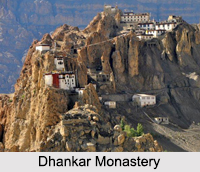 Dhankar Monastery, also known as Dankhar, Drangkhar or Dhangkar Gompa, is a Buddhist temple situated in Lahaul-Spiti District of Himachal Pradesh. It is situated at an altitude of 3,894 meters in the Spiti Valley above Dhankar Village, between the towns of Kaza and Tabo. The location of the monastery is considered to be one of the most spectacular locations for monastery, because from the gompa the confluence of the Spiti and Pin Rivers can clearly be seen. The name Dhankar has been derived from Dhang (cliff) and kar (fort), which means fort on a cliff. Dhankar Monastery was constructed on the Central Tibetan pattern, which was supposed to have had almost 90 monks in the year 1855. Currently there are 150 lamas residing in the Dhankar Monastery.
Dhankar Monastery, also known as Dankhar, Drangkhar or Dhangkar Gompa, is a Buddhist temple situated in Lahaul-Spiti District of Himachal Pradesh. It is situated at an altitude of 3,894 meters in the Spiti Valley above Dhankar Village, between the towns of Kaza and Tabo. The location of the monastery is considered to be one of the most spectacular locations for monastery, because from the gompa the confluence of the Spiti and Pin Rivers can clearly be seen. The name Dhankar has been derived from Dhang (cliff) and kar (fort), which means fort on a cliff. Dhankar Monastery was constructed on the Central Tibetan pattern, which was supposed to have had almost 90 monks in the year 1855. Currently there are 150 lamas residing in the Dhankar Monastery.
Structure of Dhankar Monastery
The 1000 years old Dhankar Monastery is associated with the Great Translator, Rinchen Zanggpo, and its complex comprises a number of multi-storey buildings perched together. The monastery has five different halls, including Kanjur, Lhakhang, and Dukhang.
Sculptures in Dhankar Monastery
The main attraction of this monastery is the huge silver image of Vajradhara, which has been kept in a glass altar and adorned with scarves and flowers. The monastery is also beautified with the depictions of Shakyamuni, Tsongkhapa, and Lama Chodrang on the central wall. There is also a statue of Vairochana or Dhayan Buddha with four figures seated back to back inside the monastery. There are also some Buddhist scriptures in Bhoti language, murals of Medicine Buddha, protector deities, and Buddhist thangkas inside the Dhankar Monastery.
Visiting Information to Dhankar Monastery
Dhankar village is well connected to roads. The village can be reached from Tabo or Kaza via Schichling by car or buses.



















